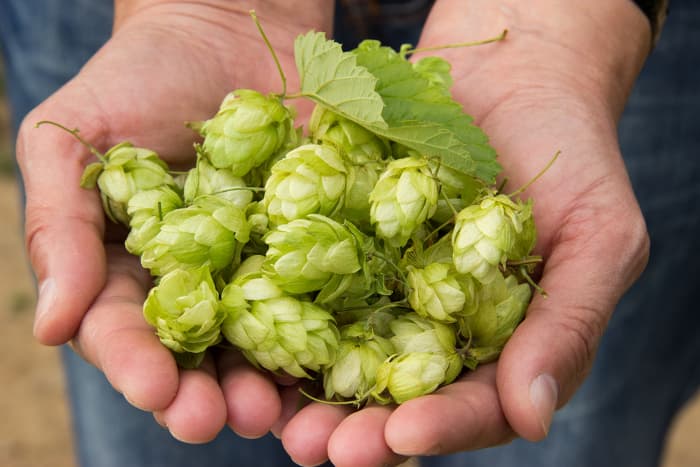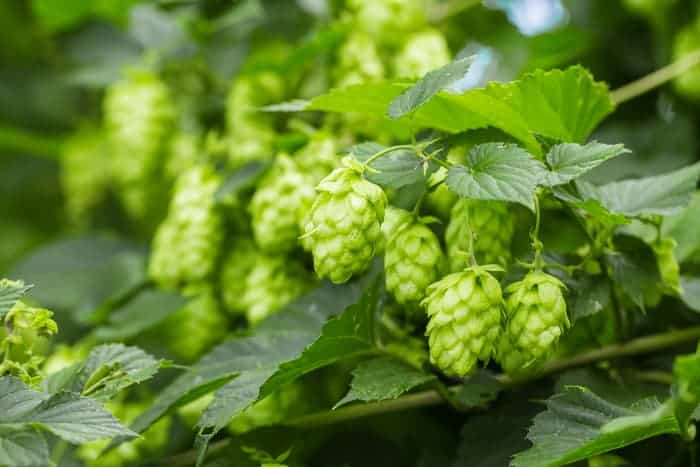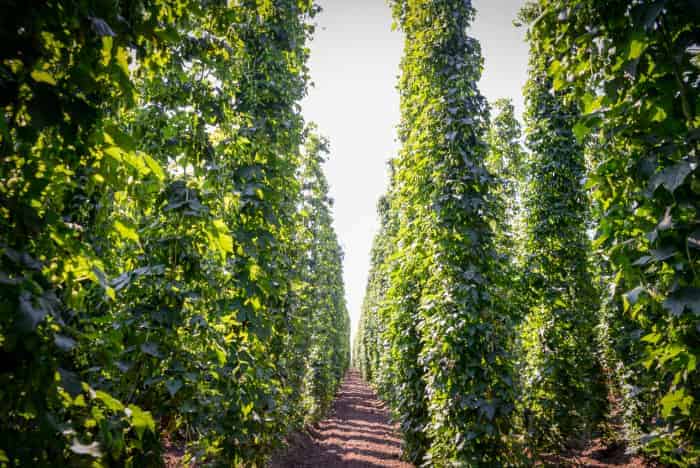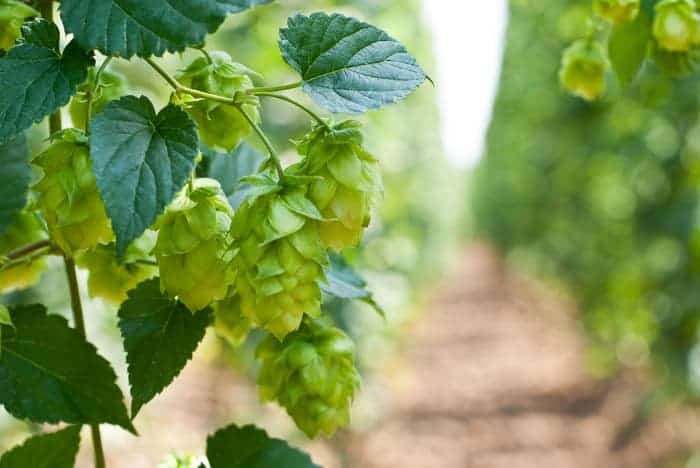Different countries have different hop varieties that they consider the cornerstones of brewing beer. Germany and Belgium have the original noble hops. Australia and New Zealand have more recently been producing a wide variety of flavor and aroma hops. In the United States, however, Willamette hops are often considered our pride and joy when it comes to home-grown hops.

If you’re curious about where Willamette is grown and how it was discovered, you’ve come to the right place. We’ll also discuss some of the important characteristics of Willamette and how you can use it in a homebrew.
History and Origin of Willamette Hops
Unlike some hop varieties that are happy discoveries, Willamette was specially bred and crafted for a purpose. The creation process started in 1967 in the Willamette Valley of Oregon by Al Haunold as a variation of the Fuggles variety. It was released and approved by the USDA in 1971 and has gone on to become the king of American aroma hops.
While the hop variety was originally intended as a variation rather than a replacement for other hops, it’s gone on to become the most popular hop plant in the United States. Nearly 20% of all hops grown in the country are Willamette Hops.
General Characteristics
Willamette is used almost exclusively for flavor and aroma rather than for bitterness. It’s loved for the spicy, floral, and fruity fragrances that it brings forth in beer, namely in ales and lagers. It tends to impart a peppery and herbaceous spice with fruity and floral notes, along with low levels of bitterness. While Willamette is susceptible to mold, mildew, and low yields, it stores and packs very well, making it the most-grown hop variety in the country.
Flavor & Aroma Profile
The main flavors and aromas that Willamette brings forth are spice, floral, herbal, and fruit. The fruitiness, however, is usually on the lower end of the spectrum, and Willamette is usually described as earthy or peppery rather than fruity.

Brewing Values of Willamette Hops
Here are the brewing values for Willamette hops. Keep in mind that every year produces, different quantities and qualities of Willamette, so these numbers are based on what is usually produced.
- Alpha Acid – 4-6%
Alpha acids are the primary source of bitterness for beer, and the longer you boil Willamette hops, the more bitter it will be.
- Beta Acid – 3-4.5%
Beta acid might have acid in the name, but it doesn’t contribute to a beer’s bitterness, unlike Alpha. Betas’ purpose is to contribute flavor and aroma profile to a beer.
- Alpha-Beta Ratio – 1:1 – 2:1
The ratio you use for adding Alpha and beta acids will determine how bitter your brew is.
- Co-humulone as % of Alpha – 28-35%
The lower the cohumulone % is, the less bitter your beer will be. Higher levels will result in a more bitter taste.
- Total Oils 0.6-1.6 mL
Oils will also add flavor and aroma to the final product. Here are the different oils used with Willamette hops.
- Myrcene – 22-55%
- Humulene – 20-35%
- Caryophyllene – 7-15%
- Farnesene – 5-10%
- All Other Oils – 0-40%
Beer Styles That Use Willamette Hops
There are a number of tasty beer styles that use Willamette hops as a primary or secondary hop.
- Pale, Brown, or Amber Ales
- Stouts and Porters
- Cream, British, and Golden Ales
- India Pale Ales and Irish Red Ales
- Wheat Beer
- Maibocks

Beers That You Can Buy That Use Willamette Hops
If you’re looking specifically for a beer that uses Willamette hops as their only hop variety, here are a few excellent commercial options.
- The Abita Brewing Company makes one of the best beers using Willamette, Turbodog
- Make sure to try the Santa Fe Brewing Company’s namesake beer, the Santa Fe Nut Brown
- Boston Irish Stout made by the Harpoon Brewing Company is another winner
Aside from these, there are a number of brews that use Willamette in addition to other varieties.
Common Substitutions For Willamette Hops
If you have trouble getting your hands on Willamette, here are a few similar varieties you can use in its place.
- Glacier
- Fuggle
- Tettnang
- Styrian Golding
- East Kent Golding
How to Grow Your Own Willamette Hops
Have we got you curious and thirsty enough to try to grow your own Willamette hops yet? If so, here is some crucial information that you’ll need.

Water
Like all hops, Willamette needs plenty of water, especially in the first two years of growth. Water Willamette regularly so that the soil remains moist but not flooded. You should be able to stick your finger two inches into the ground at all times and feel moisture.
Light
Willamette requires 6 to 8 hours of sunlight per day. Full sun is ideal unless you live in warmer climates with high temperatures. Where the temperature is consistently in the 80s and 90s, your plant will need a mixture of sun and shade.
Soil
Sandy, well-drained loam soil with a pH level between 6.0 and 7.0 is best for growing Willamette hops. You’ll want to plant your rhizome at least four inches deep in the ground and allow enough space for your plant’s roots to spread. Planting each Willamette hop plant 3 to 5 feet apart should be sufficient.
Zones
Hops plants are hardy and can thrive in hardiness zones 3 through 8. It’s best to plant Willamette hops between the months of February and April because they can withstand cold temperatures for the most part. However, you want to avoid planting them until after the last frost of the year.

Pruning
Keep your hop plants trimmed to maintain good growth and reduce pests and diseases. Trimming is also key to keeping hop plants growing vertically instead of horizontally. If needed, use a pole or post to help train your plants to grow in a vertical direction. At times, you may need to also introduce a fungicide or herbicide into the hop growth process to keep mildew and pests at bay.
Outdoor
Willamette will grow to a height of 20-25 feet tall, so you’ll want to plant them outdoors. You should also provide a trellis or support system to aid them as they grow tall.
Where To Purchase Willamette Hops
If you’re intrigued by the idea of brewing your own beer using Willamette Hops, you can purchase your hop pellets here.
Final Thoughts About Willamette Hops
Whether you want to grow your own rhizome, brew with the pellets, or just sample a beer with Willamette in it, you should definitely do so. Willamette is a crucial part of America’s beer history, and we should all take part in it!

To learn more about other kinds of hops you can use for home brewing, read our hops profile blog posts.
- About the Author
- Latest Posts
Jalin Coblentz was born and raised in northeast Ohio in the heart of farming country and grew up working in the family garden growing corn, tomatoes, potatoes, and a wide range of vegetables.
Canning and preservation were also a way of life for Jalin growing up, and he spent countless hours helping his mother, grandmother, and aunts with these duties. It’s now his passion to share his skills and knowledge with others to help them achieve their own growing goals.

